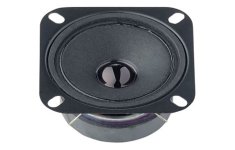Here in pictures if you ever wondered how to remove a dust cap without damaging a driver.
With this tweak I changed a "bass driver" to a fullrange driver. Got approximately +4 to 5 decibels above 1.5 kHz.
The aluminium voice coil emanates a lot of good high frequencies usually getting lost being buried by a dustcap.
I use further dsp correction together with a current drive amp to lower distortion and get linear response.
Usually I cover both sides of the diaphragm with aluminium foil to get a sandwich cone as DIY "for free"
With this tweak I changed a "bass driver" to a fullrange driver. Got approximately +4 to 5 decibels above 1.5 kHz.
The aluminium voice coil emanates a lot of good high frequencies usually getting lost being buried by a dustcap.
I use further dsp correction together with a current drive amp to lower distortion and get linear response.
Usually I cover both sides of the diaphragm with aluminium foil to get a sandwich cone as DIY "for free"
Attachments
-
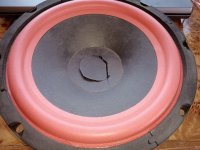 IMG_20230318_115006.jpg492.2 KB · Views: 254
IMG_20230318_115006.jpg492.2 KB · Views: 254 -
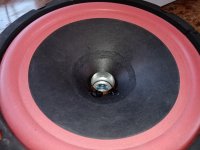 IMG_20230318_115540.jpg382.3 KB · Views: 237
IMG_20230318_115540.jpg382.3 KB · Views: 237 -
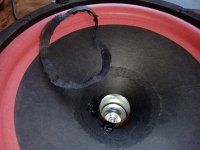 IMG_20230318_115418.jpg346.8 KB · Views: 225
IMG_20230318_115418.jpg346.8 KB · Views: 225 -
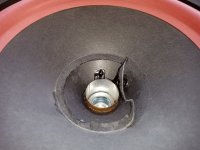 IMG_20230318_115401.jpg376.1 KB · Views: 242
IMG_20230318_115401.jpg376.1 KB · Views: 242 -
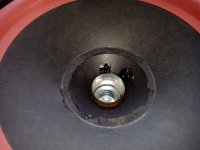 IMG_20230318_115231.jpg404.7 KB · Views: 226
IMG_20230318_115231.jpg404.7 KB · Views: 226 -
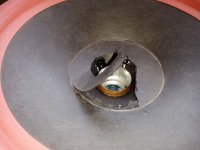 IMG_20230318_115143.jpg409.5 KB · Views: 254
IMG_20230318_115143.jpg409.5 KB · Views: 254 -
 IMG_20230318_115135.jpg300.6 KB · Views: 232
IMG_20230318_115135.jpg300.6 KB · Views: 232 -
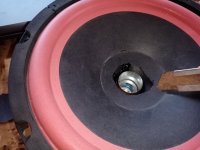 IMG_20230318_115047.jpg294.7 KB · Views: 227
IMG_20230318_115047.jpg294.7 KB · Views: 227 -
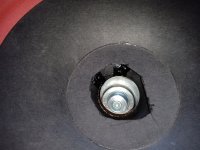 IMG_20230318_115032.jpg596.8 KB · Views: 241
IMG_20230318_115032.jpg596.8 KB · Views: 241
Before doing this I measured the driver if it has wide frequency capabilities.
With dust cap only up to 8khz.
Without up to 10khz and the said+5 dB in the higher frequency range
With dust cap only up to 8khz.
Without up to 10khz and the said+5 dB in the higher frequency range
As we see this cheapo driver has no vented pole piece and no venting holes in the voice coil former.
So removing the dust cap helps omitting resonances and nasal coloration of sound.
So removing the dust cap helps omitting resonances and nasal coloration of sound.
what about replacing it, that might have to do since I have a metal burr inside that needs to be removed?
Or you form a metal dust cap and put it directly onto the voice coil.
From measurements I know you lose some decibels on axis again but you gain some decibels out of axis as a dome emanates with wider dispersion than leaving it completely open.
If you want to keep it simple just leave it like this. Beaming in the highs can be lessened with indirect reflecting tweeters behind the box, the sides or on top.
Here is important that the side tweeters should strictly work only above 5 kHz. Then the imaging of the fullrange driver is not disturbed.
Steep filter 18db or tweeters with natural steep fall below 5khz should be used.
From measurements I know you lose some decibels on axis again but you gain some decibels out of axis as a dome emanates with wider dispersion than leaving it completely open.
If you want to keep it simple just leave it like this. Beaming in the highs can be lessened with indirect reflecting tweeters behind the box, the sides or on top.
Here is important that the side tweeters should strictly work only above 5 kHz. Then the imaging of the fullrange driver is not disturbed.
Steep filter 18db or tweeters with natural steep fall below 5khz should be used.
A voice coil former itself has some underrated square centimeters of surface which beams high frequencies.
It's mainly beaming on axis this is the only drawback. But this can be helped.
It's mainly beaming on axis this is the only drawback. But this can be helped.
The 5khz rule for side tweeters could be learned about from Peter Pfleiderer (who constructed the FRS20 fullrange loudspeaker with three side tweeters, I have a pair of them).
In his book "Lautsprecher auf den Punkt gebracht" he refers to Werner Haas (giving Name to the "Haas effect")
https://de.m.wikipedia.org/wiki/Haas-Effekt
I needed several tests for making a loudspeaker sound OK with side tweeters. They should have narrow dispersion as they should not interfere with the main driver which is important for imaging.
In his book "Lautsprecher auf den Punkt gebracht" he refers to Werner Haas (giving Name to the "Haas effect")
https://de.m.wikipedia.org/wiki/Haas-Effekt
I needed several tests for making a loudspeaker sound OK with side tweeters. They should have narrow dispersion as they should not interfere with the main driver which is important for imaging.
This can be seen as part two.
https://www.diyaudio.com/community/threads/how-to-make-a-whizzer-cone.398063/
After removing the dust cap make a whizzer cone of your own (DIY).


How to make a sandwich loudspeaker cone:
https://www.diyaudio.com/community/threads/how-to-make-a-loudspeaker-sandwich-cone.402917/
https://www.diyaudio.com/community/threads/how-to-make-a-whizzer-cone.398063/
After removing the dust cap make a whizzer cone of your own (DIY).
How to make a sandwich loudspeaker cone:
https://www.diyaudio.com/community/threads/how-to-make-a-loudspeaker-sandwich-cone.402917/
- Home
- Loudspeakers
- Full Range
- How to remove a dustcap
